NEEP533 Course Notes (Spring 1999)
Resources from Space
Resource Limitations on Earth
Lec 4, NEEP/G&G 533, Spring 1999
Geologic Processes and the Formation of Mineral Deposits
- On the Earth:
- Surface of the Earth 104K JPG
- Interior of the Earth 43K JPG
- What is a Mineral Deposit?
- Ore Forming Processes 24K GIF
- Plate Tectonics and Ores 77K JPG
- Ore Forming Processes and Cycles
- Geologic Time and Ores
What is an Ore Deposit?
- Concentration of minerals
- Recoverable at a profit
- Dynamic function of economic, engineering, political, and environmental factors
US Bureau of Mines Box
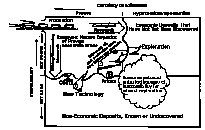 17K GIF
17K GIF
- Reserves
- identified geologically and are economic at present
- Reserve Base
- reserves plus identified lower quality material
- Resources
- reserve base plus any other concentration to be found in the future - educated guess
Ore Minerals and Ore Forming Processes
- Ore mineral(s)
- Gangue minerals - waste
- Grade or concentration - geologic factor
- Cut-off Grade - economic factor
- Size of Deposit
Geologic Processes
- Surface Processes
- Weathering, Sedimentation (clastic and chemical)
- Subsurface Processes
- Actions of Fluids
- Magmas, Brines, Groundwater
- Chemical & Physical Processes
Ex: Surface Processes
- Chemical & Physical Weathering
- Regolith and Soils
- Removal of Soluble Constituents
- Redistribution of Material
- Laterites - Fe, Al, (Ni)
Ex: Clastic Sedimentary Processes
- Beach Sands
- Placers
- Gold, Titanium, Magnetite, Uraninite
- Paleoplacers
- Ex: Witwatersrand, South Africa
Ex: Chemical Sedimentary Processes
- Precipitation from water
- Isolated Basins
- Evaporites
- Marine: Gypsum, Halite, Sylvite
- Lacustrine: Trona (sodium salts)
- Banded Iron Formations
- Sedimentary Exhalative Deposits
Reserve and Resource Estimation
- Earth's mineral endowment = Resource
- Fraction which has been identified and can be extracted at a profit = Reserve
- Estimates of these rely on Geology and Statistics
Geological Estimates
- Based on actual observation
- Individual deposit data is collected and compiled
- Such estimates only give us measured and perhaps indicated reserves
- How can we know resources?
- Categorize favorable geological environments - the educated guesssing
Resource Estimation
- Particular commodities occur in only certain geological settings
- Searches can be focused after or during routine mapping
- Can identify probabilities of finding specific settings
- This may work with known deposit types but fails for those resources in deposit types not yet known or recognized
Statistical Estimates
- Usually hinge on the assumption that the mineral reserve can be treated as a single homogenous population
- This allows estimates of the whole to be made from partial information
- NO information on the where; only the how much
- Several empirical observations have been made
Crustal Abundance Relation
- Reserves for some elements exhibit a constant ratio to their average crustal abundance
- Reserves for less explored commodities can be estimated from well explored ones
- See Fig 13-1 A. for such a plot
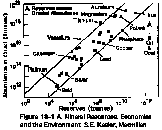 9K
GIF
9K
GIF
Lasky Relation
- Logarithmic increase in volume with an arithmetic decrease in grade
- Exact ratio varies with deposit type
- See Fig 13-1 B for example of Cu
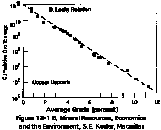 7K
GIF
7K
GIF
Watch out for Extrapolation!
- Infinite resource with infinitely low grade
- Nonsense of course
- Neglects energy costs
- Assumes that the element/deposit remains the same in different
rock types
- Elements may form own mineral at "high" concentrations
- But substitutes in crystal structure of another mineral at "low" concs.
Combined Estimates are BEST
- Ex: Oil and Gas in the U.S.
- Similar data hard to acquire for most metals
- Where present, a single country's data is often masked by world wide production
Additional Factors
- Stockpiles
- Strategic minerals; definition changes
- Abnormal factor in nominally "free market"
- Recycling
- Most perfect form of mineral use
- Not possible with many things however
- (Will be KEY in space)
World Reserves and the Future
- Divide reserve figures by present consumption
- 1992 data shown in Figure 13-5
 36K
GIF
36K
GIF
- Some things are in very short supply
Use Reserve Base Instead of Reserves?
- Provides a longer term perspective
- 1 to 5 times more material available than in reserve calculation
- However what is the fallacy with this logic?
Population and Standard of Living will Increase Significantly
- Therefore present consumption is a minimum for the future
- 2 to 3 times greater consumption as an average for the next 10-50 years is likely
- Maybe twice the time shown in the Table before we run out of certain materials
Additional Problems with this Summary
- Source of the numbers: compare 1964 to early 1980's consumption
- Fig. 6-2
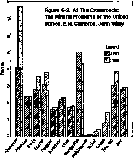 16K GIF
16K GIF
- RB/P does not tell us the rate at which a commodity can be produced
- Doesn't tell us what price is needed to make the reserve base available
Price vs Consumption
- Availability can be markedly influenced by price
- Fig. 6.1 shows U.S. consumption vs Price
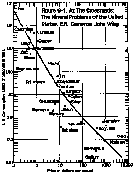 15K
GIF
15K
GIF
- Cut the price by factor of 10 = consumption will increase 20-50 times
How to Forecast Future Production?
- Look at past 20-30 years for guidance
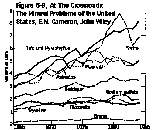 9K GIF
9K GIF
- Examine and anticipate technological change
- How can we anticipate events like the oil embargo?
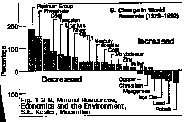 12K GIF
12K GIF
The Real Significance of these Numbers:
- How long to find reserves and put them into production?
- Reserves are of no use if left in the ground
- Exploration takes a long time
- Development can take a long time
- Time is Money
How does this apply to Space?
- Some rules the same, some different
- "crustal abundances"
- economies of scale
- substitution possible?
- role of recycling
- Technological constraints
References and a more complete treatment of mineral resources issues on the Earth can be found in my course Minerals as a Public Problem.
 |
|
University of Wisconsin Fusion Technology Institute · 439 Engineering Research Building · 1500 Engineering Drive · Madison WI 53706-1609 · Telephone: (608) 263-2352 · Fax: (608) 263-4499 · Email: fti@engr.wisc.edu |
Copyright © 2003 The Board of
Regents of the University of Wisconsin System.
For feedback or accessibility issues, contact
web@fti.neep.wisc.edu.
|
